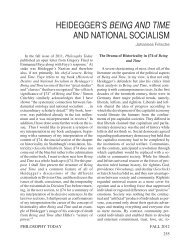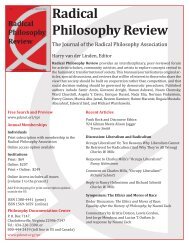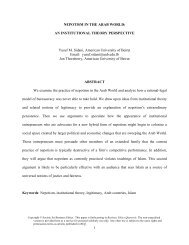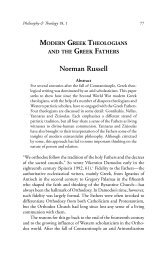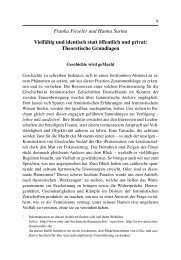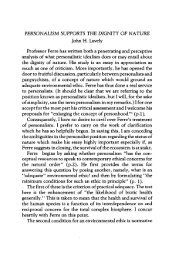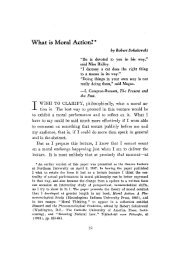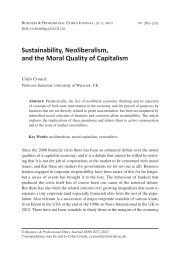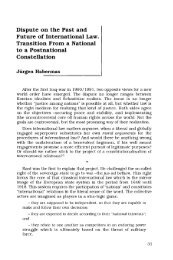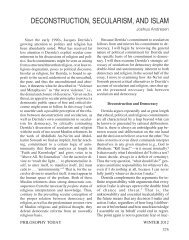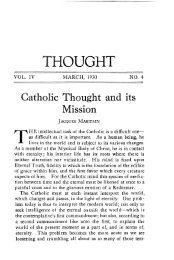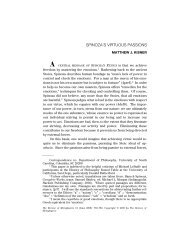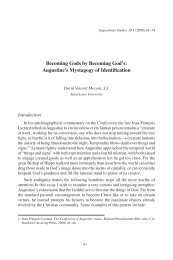Perverted Conversions: - Philosophy Documentation Center
Perverted Conversions: - Philosophy Documentation Center
Perverted Conversions: - Philosophy Documentation Center
You also want an ePaper? Increase the reach of your titles
YUMPU automatically turns print PDFs into web optimized ePapers that Google loves.
— 136 —<br />
Rachel Walsh<br />
• • •<br />
mandates rather than political concerns. 6 Discursively spectralized in the Abu Ghraib<br />
photographs, the Islamic Other is painfully staged as one whose shame is a contemptible<br />
sign of their uncivilized state, and as one who must be punished with<br />
the cultural edicts that they are presumed to be solely governed by.<br />
I argue that images of Abu Ghraib are egregious and concentrated emblems<br />
of civilizational discourses already in circulation, particularly in the U.S. and to a<br />
lesser degree in the former colonial European nations. Indeed, Abu Ghraib is framed<br />
by a larger narrative of flawed, post-9/11 multicultural humanism, which as David<br />
Palumbo-Liu argues, is “a rearticulation of civilizational thinking along the axis of<br />
developed capitalist states.” 7 We are all human; we are all different — some are just<br />
more different and less human than others.<br />
The photographs of Abu Ghraib continue to haunt us, and should continue<br />
to haunt us, not because they show that this familiar refrain has suddenly been<br />
implemented as the U.S.’s foreign policy. Such an assertion would be both historically<br />
inaccurate and would suggest that the exercise of power precedes the ideology.<br />
Instead, the photographs expose how civilizational discourses allow for, and indeed<br />
help create, the legal and ethical vacuum in which sovereign power can be exerted<br />
against individuals whose bodies, racially, ethnically, and culturally, were never<br />
thought of as human to begin with. The effacement of the prisoners that occurs<br />
throughout the photographs, most pronouncedly with the figures of the hooded<br />
men, is preceded by a prior effacement. Judith Butler observes, “Those who remain<br />
faceless or whose faces are presented to us as so many symbols of evil, authorize<br />
us to become senseless before those whose lives we have eradicated, and whose<br />
grievability is indefinitely postponed.” 8 If the photographs are jarring it is because<br />
they disrupt that prolonged postponement and force the viewer to consider how<br />
this prior effacement (configuring all Arabs as cultural and religious Others, the<br />
failure to fully account for the deaths of Arabic citizens, Palestinians, Afghanstanis,<br />
Iraqis) produces the effacement and the simultaneous vulgar ventriloquization of<br />
“Islam” depicted in the photographs.<br />
In what follows, I examine the grossly aestheticized conversion in which the<br />
humanity of the Iraqi prisoners is disavowed and their bodies are reduced to<br />
caricaturized figures of the Islamic Other who forever necessitates, yet denies the<br />
efficacy of, American imperialism. Reading this perverse conversion as an insidious<br />
culmination of medieval sovereign exercises of power over the body and what Foucault<br />
6. Brown, Regulating Aversion, p. 151.<br />
7. David Palumbo-Liu, “Multiculturalism Now: Civilization, National Identity, and Difference<br />
Before and After September 11th,” Boundary 2 29, no. 2 (2002): p. 114.<br />
8. Judith Butler, Precarious Life: The Power of Mourning and Violence (New York: Verso<br />
Books, 2004), p. xviii.



